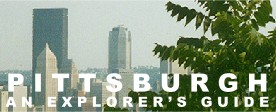|
|
|

Traditionally, Oakland has been the cultural center of Pittsburgh. Even though some of the cultural organizations have moved downtown in recent years (notably the symphony, the opera, and the ballet), Oakland is still the brains of Pittsburgh, and one of the great intellectual centers of the world.
Two
major universities define Oakland. The University of Pittsburgh owns a
good bit of the land, and its Cathedral of Learning is the symbolic center
of Oakland. Carnegie-Mellon University is not quite so large as Pitt, but
it's known all over the world as a center of heavy thinking--particularly
in the fields of robotics, artificial intelligence, and the Internet.
In addition to the universities, many of Pittsburgh's most important cultural institutions live in Oakland. Foremost among them is the Carnegie, a gigantic complex of art museum, natural-history museum, library, concert hall, and lecture hall.
The Carnegie Museum of Natural History has one of the world's great collections of dinosaur bones; expeditions from the museum discovered the first brontosaur, the first tyrannosaur, and the first diplodocus (a life-size model of Diplodocus carnegii stands at the western end of the Forbes Avenue front).
The Carnegie Museum of Art is famous for its collection of Impressionists and for the Carnegie International, one of the world's most important regular exhibitions of contemporary art.
Phipps
Conservatory, across the Junction Hollow bridge from the Carnegie,
is a beautifully ornate Victorian glasshouse with a spectacular collection
of tropical plants. The gardens are a favorite spot for weddings.
At the other end of Oakland is the gigantic Oakland medical complex, a huge tangle of hospitals and research institutes that has become the organ-transplant capital of the world. Local papers are always running heartwarming stories of poor little Russian boys whose lives were saved by heroic Oakland doctors.
Fifth Avenue is the monumental boulevard of Pittsburgh, where the ornate classical buildings housing venerable Pittsburgh institutions are lined up one after another.
The business center of Oakland is the lively shopping district along Forbes Avenue. Since it caters especially to university students and professors, it has the character of a college town.
Atwood Street, which crosses Forbes Avenue in the heart of the business district, is a residential street with mostly student housing, but it has the best collection of little ethnic restaurants in Pittsburgh.
Craig Street is the upscale trendy shopping street across from the Carnegie Museum of Art. It's lined with bookstores, cafes, restaurants, and galleries.
In
spite of the bustle and monumentality, Oakland--especially South Oakland--is
also full of quiet, working-class residential streets lined with Victorian
rowhouses. These back-street neighborhoods have their own little business
districts, notably along Bates and Semple Streets.
Schenley Farms is a small neighborhood of beautifully preserved upper-class houses surrounded by the university and monument districts. The streets are named after great writers of the nineteenth century--Tennyson, Ruskin, Parkman, and (of all people) Lytton.
Northeastern Oakland is full of large apartment blocks. Its main business streets are Craig Street and Centre Avenue.
Much of the eastern part of Oakland is taken up by Scehnley Park, a beautiful green oasis surrounded by crowded city neighborhoods.